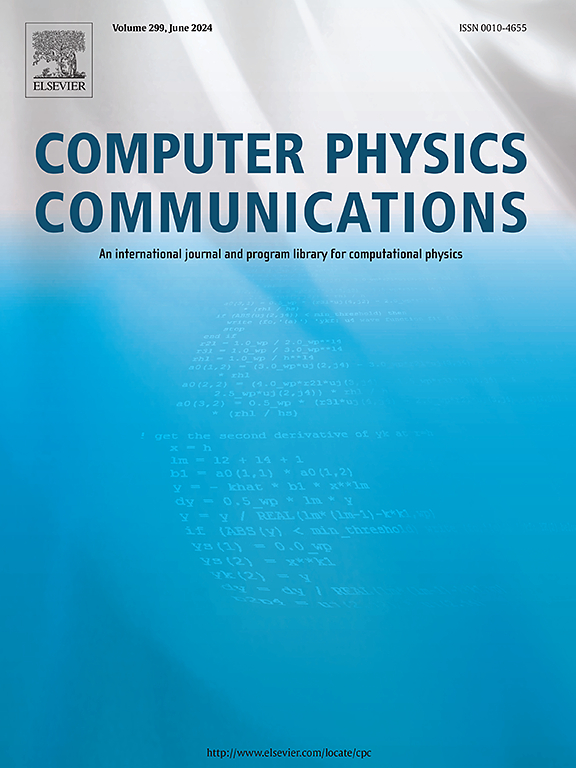Galactic distribution of supernovae and OB associations
IF 7.2
2区 物理与天体物理
Q1 COMPUTER SCIENCE, INTERDISCIPLINARY APPLICATIONS
引用次数: 0
Abstract
We update and extend a previous model by Higdon and Lingenfelter for the longitudinal profile of the N II intensity in the Galactic plane. The model is based on four logarithmic spiral arms, to which features like the Local Arm and local sources are added. Connecting then the N II to the H II emission, we use this model to determine the average spatial distribution of OB associations in the Milky Way. Combined with a stellar mass and cluster distribution function, the model predicts the average spatial and temporal distribution of core-collapse supernovae in the Milky Way. In addition to this average population, we account for supernovae from observed OB associations, providing thereby a more accurate description of the nearby Galaxy. The complete model is made publicly available in the python code SNOB.
Program summary
Program Title: SNOB 1.1: Simulating the distribution of SuperNovae and OB associations in the Milky Way.
CPC Library link to program files: https://doi.org/10.17632/hz5vbsvy7d.1.
Licensing provisions: CC by NC 3.0.
Programming language: Python 3.8
Nature of problem: Determination of the distribution of OB associations from the observed N II line intensity; derivation of the resulting distribution of core-collapse supernovae.
Solution method: Numerical integration of line-of-sight integrals for the N II line intensity; Monte Carlo simulation of the spatial and time distribution of OB associations and core-collapse supernovae in the Milky Way.
超新星在银河系的分布和OB的关联
我们更新和扩展了Higdon和Lingenfelter先前的模型,用于银道面N II强度的纵剖面。该模型基于四个对数螺旋臂,并加入了局部臂和局部源等特征。然后将N II和H II的发射联系起来,我们使用这个模型来确定银河系中OB关联的平均空间分布。结合恒星质量和星团分布函数,该模型预测了银河系中核心坍缩超新星的平均时空分布。除了这个平均数量外,我们还考虑了观测到的OB关联的超新星,从而提供了对附近星系更准确的描述。完整的模型在python代码SNOB中公开提供。项目简介项目名称:SNOB 1.1:模拟超新星和OB在银河系中的分布。CPC库链接到程序文件:https://doi.org/10.17632/hz5vbsvy7d.1.Licensing规定:CC由NC 3.0。问题性质:根据观察到的N II线强度确定OB关联的分布;核心坍缩超新星分布的推导。求解方法:对nii线强度的视距积分进行数值积分;银河系OB联合和核心坍缩超新星时空分布的蒙特卡罗模拟。
本文章由计算机程序翻译,如有差异,请以英文原文为准。
求助全文
约1分钟内获得全文
求助全文
来源期刊

Computer Physics Communications
物理-计算机:跨学科应用
CiteScore
12.10
自引率
3.20%
发文量
287
审稿时长
5.3 months
期刊介绍:
The focus of CPC is on contemporary computational methods and techniques and their implementation, the effectiveness of which will normally be evidenced by the author(s) within the context of a substantive problem in physics. Within this setting CPC publishes two types of paper.
Computer Programs in Physics (CPiP)
These papers describe significant computer programs to be archived in the CPC Program Library which is held in the Mendeley Data repository. The submitted software must be covered by an approved open source licence. Papers and associated computer programs that address a problem of contemporary interest in physics that cannot be solved by current software are particularly encouraged.
Computational Physics Papers (CP)
These are research papers in, but are not limited to, the following themes across computational physics and related disciplines.
mathematical and numerical methods and algorithms;
computational models including those associated with the design, control and analysis of experiments; and
algebraic computation.
Each will normally include software implementation and performance details. The software implementation should, ideally, be available via GitHub, Zenodo or an institutional repository.In addition, research papers on the impact of advanced computer architecture and special purpose computers on computing in the physical sciences and software topics related to, and of importance in, the physical sciences may be considered.
 求助内容:
求助内容: 应助结果提醒方式:
应助结果提醒方式:


